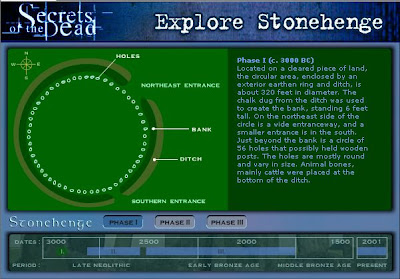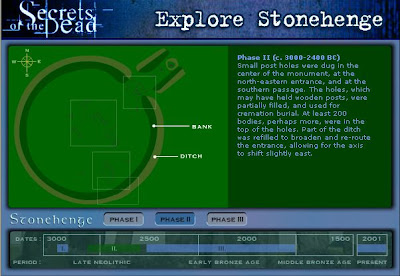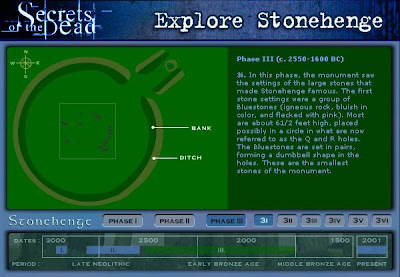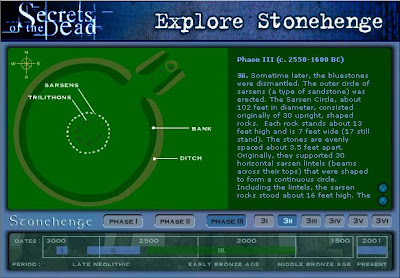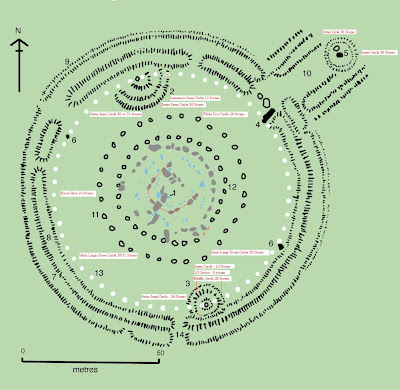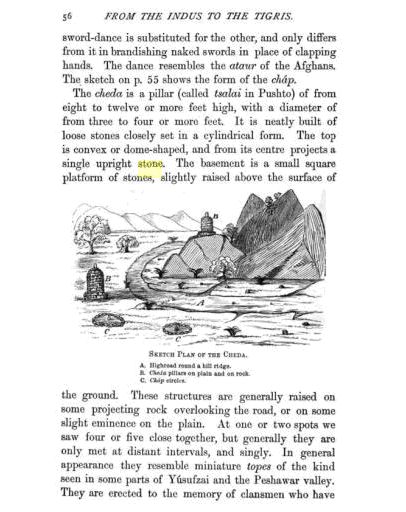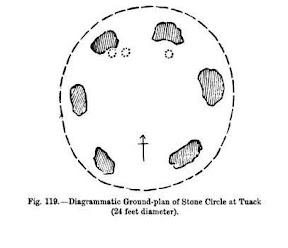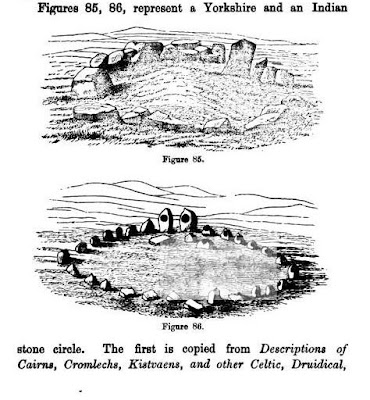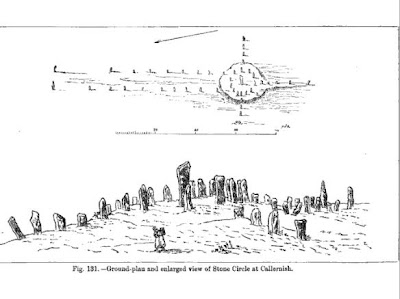I have adapted this from Anacalypsis and Celtic Druids, by Geoffry Higgins.
The profound doctrines of abstractions or emanations; of the absorption of the individual soul into the divine ether or essence; of the renewal of worlds and reincarnation, were doubtless elaborated after the separation, in the human mind, of Spirit from matter, but before mankind had lost the power to reason abstractly.
Although Pythagoras understood and believed these doctrines, he did not, as is well known, receive them from his degenerate countrymen, but, on the contrary, imbibed them from private sources among the orientals, where fragments of their remarkable learning were still extant. He said that religion consists in knowing the truth and doing good, and his ideas show the grandeur and beauty of the earlier conception of a Deity. He declared that there is only one God who is not, "as some are apt to imagine, seated above the world, beyond the orb of the universe," but that this great power is diffused throughout Nature. It is "the reason, the life, and the motion of all things."
Plato believed that human beings are possessed of two souls, the one mortal, which perishes with the body, the other immortal, which continues to exist either in a state of happiness or misery; that the righteous soul, freed from the limitations of matter, returns at death to the source whence it came, and that the wicked, after having been detained for a while in a place prepared for their reception, are sent back to earth to reanimate other bodies. (My Note)My Note: This echos of things said in Bhagwat Gita and other Hindu Scriptures, much before Plato.Aristotle held the opinion that the souls of human beings are sparks from the divine flame (My Note 1), while Zeno, the founder of the Stoic philosophy, taught that spirit acting upon matter produced the elements and the earth (My Note 2). There is plenty of evidence going to show that the early Fathers in the Christian church believed in the doctrines of reincarnation and the renewal of worlds (My Note 3). Neither is there any doubt but that this philosophy came from the East, where it originated. It is thought that the ancient philosophers who elaborated these doctrines were unable to account for the existence of evil without a belief in the immortality of the soul. Spirit was eternal, as was also matter.A soul, upon leaving the body, in course of time found its way back to earth, surrounded by conditions suited to its stage of growth. Here it must reap all the consequences of its former life. It must also during its stay on earth make the conditions for its next appearance upon an earthly plane. So soon as through a succession of births and deaths it had perfected itself, it entered into a state of Nirvana. It was absorbed into the great Universal Soul. Nothing is ever lost. (My Note 4)My Notes: (1) Bhagwat Gita, Vedanta and other Hindu Scriptures mention this. (2) Sankhya Philosphy, (3) Bhagwat Gita talks about it, (4). Bhgwat Gita and Vedanta talk about it. Some noted western professor said that Hindoos were the first people to understand the Law of Conservation of Matter and Energy, which were seperately stated for matter and energy until Albert Einstein combined them into a famous E=MC^2.
"Many a house of life Hath held me--seeking ever Him who wrought These prisons of the senses, sorrow fraught; Sore was my ceaseless strife! But now, Thou builder of this tabernacle--Thou! I know Thee. Never shalt Thou build again These walls of pain, Nor raise the roof-tree of deceits, nor lay Fresh rafters on the clay; Broken Thy house is, and the ridge-pole split! Delusion fashioned it! Safe pass I thence--deliverance to obtain." (Note 60)
Note 60: Edwin Arnold, The light of Asia.Regarding the opinions of the ancients on the subject of the eternity of matter, Higgins, in his learned work on Celtic Druids, says:
"The eternity of matter is a well known tenet of the Pythagoreans, and whether right or wrong there can be no doubt that it was the doctrine of the oriental school, whence Pythagoras drew his learning. It was a principle taken or mistaken from, or found amongst, the debris of that mighty mass of learning and science of a former period, of which, on looking back as far as human ken can reach, the most learned men have thought that they could see a faint glimmering. Indeed, I think I may say something more than a faint glimmering. For all the really valuable moral and philosophical doctrines we possess, Dutens has shown to have existed there."
From what is known relative to the speculations of an ancient race, the fact is observed that creation was but a re-formation of matter. Wisdom, or Minerva, formed the earth and the planets; she did not create the heavens and the earth, as did the later Jewish God.
Of the seven (My Note 1) principles of the universe, matter was the first, and of the seven principles of man, the physical body was the earliest. Through evolutionary processes, or through cyclic periods involving millions of years, mind was developed, and in course of time spirit was finally manifested. My Note 1: Hindus circumambulating 7 times in temples and in their wedding ceremony around the sacred fire, the 7 worlds of consciousness, the 7 Chakaras in Kundalini Yoga, Muslim and Pre-Muslim Idolters circumambulating Kaba Black Stone 7 times, and the 7 worlds of creation or the 7 divine emanations, watched by arch-angels in Zorastrian, Jew, Christian (Gnositicism) and Islam religion, perhaps has some common basis, perhaps on the knowledge of 5 planets and Sun and Moon by the ancients.
Mai, the Mother of Gotama Buddha (My Note 1), was simply matter, or illusion, from which its higher manifestation, mind or spirit, was emerging. She was also the mother of Mercury. A clearer knowledge of the philosophical doctrines which were elaborated at a time when Nature-worship was beginning to decay, reveals the fact that the god-idea comprehended a profound knowledge of Nature and her laws; that while this people did not pretend to account for the existence of matter, they recognized a force operating through it whose laws were unchanged and unchanging. My Note 1: This is an overloaded word for Maya, who was also the mother of Gautam Buddha, besides the word Maya associated with Brhman and Maya, where Brahman is the first principle, or for some as a male or father principle, the Shiva Prinicple, and Maya is the illusion principle or the female or mother principle, the Shakti Principle.
With these facts relative to the intelligence of an older race before us, the question naturally arises: What was the degree of civilization attained at a time when the Deity worshipped was an abstract principle involving the actual creative processes throughout Nature? and, notwithstanding our prejudices, we are constrained to acknowledge that these earlier conceptions are scarcely compatible with the barbarism which we have been taught (My Note 1) to regard as the condition of all the peoples which existed prior to the first Greek Olympiad. On the contrary, the origin of the philosophical opinions entertained by the most ancient oriental philosophers, and which must have arisen out of a profound knowledge or appreciation of Nature and her operations, point to a race far superior to any of those peoples which appear in early historic times. Regarding these opinions, Godfrey Higgins remarks:
"From their philosophical truth and universal reception I am strongly inclined to refer them to the authors of the Neros, or to that enlightened race, supposed by Bailly to have formerly existed, and to have been saved from a great catastrophe on the Himalaya Mountains. This is confirmed by an observation which the reader will make in the sequel, that these doctrines have been, like all the other doctrines of antiquity, gradually corrupted--incarnated, if I may be permitted to compose a word for the occasion."
My Note 1: Hints to the false propoganda promoted by early Christian and Islamic zealots who forced the conversions.
Of this cycle, Bailly says: "No person could have invented the Neros who had not arrived at much greater perfection in astronomy than we know was the state of the most ancient Assyrians, Egyptians, and Greeks."
Toward the close of the eighteenth century the celebrated astronomer, Bailly, published a work entitled The History of Ancient Astronomy, in which he endeavored to prove that a nation possessed of profound wisdom and great genius, and of an antiquity far superior to the Hindoos or Egyptians, "inhabited the country to the north of India, or about fifty degrees north latitude." (My Note 1) This writer has shown that "the most celebrated astronomical observations and inventions, from their peculiar character, could have taken place only in these latitudes, and that arts and improvements gradually travelled thence to the equator."
My Note 1: There are other reasons besides Astronomical observations alluded that are only possible from the northen region of India (which spanned from Uzbekistan and Tachuria to Burma, Java, Sumatra, and Indonesia - atleast in the religious and cultural influence and perhaps more). Nowhere the are so many rivers present, and nowhere there are such high mountains and valleys to survive the great flood or deluge mentioned in all nations. This regions is most probably the region of Tibet, Tachuria, Pamir Mountains, and Himalays. This is backed up by the National Geographic Study which shows man existed in this region and passed into Europe in 40, 000 BC.
A colony of Brahmins settled near the Imans, and in Northern Thibet, where in ancient times they established celebrated colleges, particularly at Nagraent and Cashmere. In these institutions the treasures of Sanskrit literature were supposed to be deposited. The Rev. Mr. Maurice was informed that an immemorial tradition prevailed at Benares that all the learning of India came from a country situated in forty degrees of northern latitude. Other writers are of the opinion that civilization proceeded from Arabia; that the old Cushite race carried commerce, letters, and laws to all the nations of the East. Which of these theories is true, if either, may not with certainty be proved at present; yet that in the far distant past a race of people existed whose achievements exceeded those of any of the historic nations may not be doubted.
That the length of the year was calculated with greater exactness by an ancient and forgotten people than it was by early historic nations is proved by the cycle of the Neros. This cycle, which was formed of 7.421 lunar revolutions of 29 days, 12 hours, 44 minutes, and 3 seconds, or 219,146 days and a half, was equal to 600 solar years of 365 days, 5 hours, 51 minutes, and 36 seconds, which time varies less than three minutes from the present observations of the year's length. The length of the year as calculated by the Egyptians and other early historic nations was 360 days, which fact would seem to indicate that a science of astronomy had been developed in an earlier age which by the most ancient peoples of whom we have any historic records has been lost or forgotten. It has been said that if this cycle of the Neros "were correct to the second, if on the first of January at noon a new moon took place, it would take place again in exactly 600 years at the same moment of the day, and under all the same circumstances." Note 61
61 Godfrey Higgins, Celtic Druids, ch. ii., sec. 14.
The Varaha Calpa has the famous cycle of 4,320,000,000 years for its duration. This system makes the Cali Yug begin 3098 years B.C. A dodecan consisted of 5 days, and 72 dodecans formed a natural year of 360 days. According to the earlier calculations, 360 solar diurnal revolutions constituted a natural year. The doctrine of the ancients concerning these cycles is thus set forth by Godfrey Higgins:
"The sun, or rather that higher principle of which the sun was the emblem (My Note 1) or the shekinah, was considered to be incarnated every six hundred years. Whilst the sun was in Taurus, the different incarnations, under whatever names they might go, were all considered but as incarnations of Buddha or Taurus. When he got into Aries, they were in like manner considered but as incarnations of Cristna or Aries, and even Buddha and Cristna were originally considered the same, and had a thousand names in common, constantly repeated in their litanies--a striking proof of identity of origin. Of these Zodiacal divisions the Hindoos formed another period, which consisted of ten ages or Calpas or Yugs, which they considered the duration of the world, at the end of which a general renovation of all things would take place. They also reckoned ten Neroses to form a period, each of them keeping a certain relative location to the other, and together to form a cycle. To effect this they doubled the precessional period for one sign-- viz: 2160 years (My Note 2) --thus making 4320, which was a tenth of 43,200, a year of the sun, analogous to the 360 natural days, and produced in the same manner, by multiplying the day of 600 by the dodecans 72 = 43,200. They then formed another great year of 432,000 by again multiplying it by 10, which they called a Cali Yug, which was measurable both by the number 2160, the years the equinox preceded in a sign, and by the number 600. They then had the following scheme:
A Cali Yug, or 600 (or a Neros) 432,000
A Dwapar, or Duo-par Age. . . . .864,000
A Treta, or tree-par Age. . . . . 1,296,000
A Satya, or Satis Age . . . . . . . . 1,728,000
Total ---------------------------- 4,320,000 (My Note 3)
The total 4,320,000 altogether 10 Ages, making a Maha Yug or Great Age. These were all equimultiples of the Cycle of the Neros 600, and of 2160, the twelfth part of the equinoctial precessional Cycle, and in all formed ten ages of 432,000 years each." Note 62
Note 62 Anacalypsis, vol. i., p. 232.
My Note 1: The re-incarnation priniciple of the Holiest Divine Emnations for restoring the Dharma or the Righteous Prinicple of God.
My Note 2: 4320,000 was the number known to Hindus, Babylonians, Egyptians, Nordics and Celts as it is mentioned in their mythology. But the science behind it was lost in the "dark" ages of the Arab, Hellenistic and Western worlds, and the their astrology not accounting for the Precision of the Earth. In fact I have read that this also encoded into the Egyptian Pyramids.
My Note 3: Western Astrology, which was based on Arab and Greece Astrology, was based on only 2 motions of the earth, the spin of 24 hours around its axis and the rotation around the sun in the solar orbital elliptic in 360/364/365 days. Only the Indian and Chinese Astrology was based on the 3rd axis of earth spin, which is the wobble, and has a periodicity of 2160 years in one Zodiac sign, coming to 2160 x 12 = 25920 years. This means that one had to definitely observe the central star, which is the North Pole of the Celestial Sphere, making a complete turn in 25920 years! This being impractical, they would observe that the Solar Solstice would rotate a Zodiac, 360/12 = 30 degrees, by 2160 years, or 1 degree every 72 years! The accuracy of the observation depends on the instruments of the ancients, which I doubt could go beyond 30 Degrees, as for 15 degrees accuracy, they had to divide the celestial circle into 24 parts, and their would have been then 24 Zodiacs! So this record keeping went on for at least 2160 years, which is backed up when one studies Stonehenge, of which I will come later and is part of this series. Also note, 2160 = 270 x x 8 = 3/4 x 360 x 8 = 6 x 360 = 72 x 30 = 144 x 15; 4320 = 72 x 2 x 15 x 2 = 144 x 30; 25920 = 144 x 180 = 288 x 90 = 72 x 360.
The two great religious festivals of the ancients occurred the one in the spring, at Easter, when all Nature was renewed, the other in the autumn, after the earth had yielded her bounties and the fruits were garnered in. It was at these gatherings that the Great Mother Earth received the devout adoration of all her children. (My Note 1)
My Note 1: This was the basis for worshiping the Sun as a Father or Male Prinicple as well, and which rose the the Phallic or Lingam Worship, seen in all parts of the word as well as the worshipping of the Earth as a Mother or Female Principle as well, which rose to the Circle or Yoni Worship all over the world, which I shall talk about later.
It is supposed that the Neros, or cycle of 600, is closely connected with this worship, and that it was invented to regulate the season for these festivals. In process of time it was discovered that this cycle no longer answered, that the festival which had originally fallen on the first of May now occurred on the first of April. This, we are told, "led ultimately to the discovery that the equinox preceded about 2160 years in each sign or 25,920 years in the 12 signs, and this induced them to try if they could not form a cycle of the two. On examination, they found that the 600 would not commensurate the 2160 years in a sign, or any number of sums of 2160 less than ten, but that it would with ten, or that in ten times 2160, or in 21,600 years, the two cycles would agree; yet this artificial cycle would not be enough to include the cycle of 25,920. They, therefore, took two of the periods of 21,600, or 43,200; and, multiplying both by ten--viz: 600 X 10 = 6000, and 43,200 X 10 = 432,000--they formed a period with which the 600-year period and the 6000-year period would terminate and form a cycle. Every 432,000 years the three periods would commence anew; thus the three formed a year or cycle, 72 times 6000 making 432,000, and 720 times 600 making 432,000." Note 63
63 Higgins, Anacalypsis, p. 235.
To form a great year, which would include all the cyclical motions of the sun and moon, and perhaps of the planets, they multiplied 432,000 by ten; thus they had ten periods answering to ten signs. Concerning these cycles Godfrey Higgins observes:
"Persons of narrow minds will be astonished at such monstrous cycles; but it is very certain that no period could properly be called the great year unless it embraced in its cycle every periodical movement or apparent aberration. But their vulgar wonder will perhaps cease when they are told that La Place has proved that, if the periodical aberrations of the moon be correctly calculated, the great year must be extended to a greater length even than 4,320,000 years of the Maha Yug of the Hindoos, and certainly no period can be called a year of our planetary system which does not take in all the periodical motions of the planetary bodies."
It is thought that as soon as these ancient astronomers perceived that the equinoxes preceded, they would at once attempt to determine the rate of precession in a given time; the precession, however, in one year was so small that they were obliged to extend their observations over immense periods. Jones informs us that the Hindoos first supposed that the precession took place at the rate of 60 years in a degree, or 1800 in a Zodiacal sign, and of 21,600 in a revolution of the entire circle. They afterwards came to think that the precession was at the rate of 60 years and a fraction of a year, and thus that the precession for a sign was in 1824 years, and for the circle in 21,888 years. Subsequently they discovered, or thought they had discovered, the Soli-Lunar period of 608 years, hence they attempted to make the two go together. Both, however, proved to be erroneous.
In referring to the fact that among the ancient Romans existed the story of the twelve vultures and the twelve ages of 120 years each, Higgins remarks:
"This arose from the following cause: They came from the East before the supposition that the precession took place a degree in about 60 years, and 1824 years in a sign had been discovered to be erroneous; and as they supposed the Neros made a correct cycle in 608 years, and believed the precessional cycle to be completed in 21,888, they of course made their ages into twelve. As both numbers were erroneous, they would not long answer their intended purpose, and their meaning was soon lost, though the sacred periods of twelve ages and of 608 remained."
According to Hipparchus and Ptolemy, the equinoxes preceded at the rate of a degree in 100 years, or 36,000 hundred years in 360 degrees. This constituted a great year, at the end of which the regeneration of all things takes place. This is thought to be a remnant of the most ancient Hindoo speculations, and not the result of observation among the Greeks. (My Note 1) Some time after the arrival of the sun in Aries, "at the vernal equinox, the Indians probably discovered their mistake, in giving about 60 years to a degree; that they ought to give 50" to a year, about 72 years to a degree, and about 2160 years to a sign; and that the Luni-Solar cycle, called the Neros, did not require 608 years, but 600 years only, to complete its period. Hence arose the more perfect Neros."
My Note 1: This shows the vector of the astronomical knowledge movement that I have observed in others areas like cultural, religious, language, philosphy as well, and accounts for the richness of Sanskrit as a language vs Greece in terms of grammer, though close, as well Greece philosphers being told to have visited the Orient schools in the East, as well as Greece admission that their God Dyniosus came from India. More on this sometime later.
It is thought by various writers that the knowledge of the ancient Hindoos regarding the movements of the sun and moon in their cycles of nineteen and six hundred years--the Metonic cycle, and the Neros--proves that long before the birth of Hipparchus the length of the year was known with a degree of exactitude which that astronomer had not the means of determining. It is positively asserted by astronomers that at least twelve hundred years were required, "during which time the observations must have been taken with the greatest care and regularly recorded," to arrive at the knowledge necessary for the invention of the Neros, and that such observations would have been impossible without the aid of the telescope.
On the subject of the great learning of an ancient race, Sir W. Drummond says:
"The fact, however, is certain, that at some remote period there were mathematicians and astronomers who knew that the sun is in the centre of the planetary system, and that the earth, itself a planet, revolves round the central fire;--who calculated, or like ourselves attempted to calculate, the return of comets, and who knew that these bodies move in elliptic orbits, immensely elongated, having the sun in one of their foci;--who indicated the number of the solar years contained in the great cycle, by multiplying a period (variously called in the Zend, the Sanscrit, and the Chinese ven, van, and phen) of 180 years by another period of 144 years;--who reckoned the sun's distance from the earth at 800,000,000 of Olympic stadia; and who must, therefore, have taken the parallax of that luminary by a method, not only much more perfect than that said to be invented by Hipparchus, but little inferior in exactness to that now in use among the moderns;--who could scarcely have made a mere guess when they fixed the moon's distance from its primary planet at fifty-nine semi-diameters of the earth; (My Note 1) --who had measured the circumference of our globe with so much exactness that their calculation only differed by a few feet from that made by our modern geometricians; --who held that the moon and the other planets were worlds like our own, and that the moon was diversified by mountains and valleys and seas;--who asserted that there was yet a planet which revolved round the sun, beyond the orbit of Saturn;--who reckoned the planets to be sixteen in number; --and who reckoned the length of the tropical year within three minutes of the true time; nor, indeed, were they wrong at all, if a tradition mentioned by Plutarch be correct." Note 64
My Note 1: It seems the diameter of Earth and Moon, and their circumfrence is encoded into Pyramids and Stonehenge.
Note 64 Drummond, On the Zodiacs, p. 36.
Bailly, Sir W. Jones, Higgins, and Ledwich, as well as many modern writers, agree in the conclusion that the Indians, the Egyptians, the Assyrians, and the Chinese were simply the depositaries, not the inventors, of science. The spirit of inquiry which in later times is directing attention to the almost buried past is revealing the fact that not merely the germs whence our present civilization has been developed descended to us from the dim ages of antiquity, but that a great number of the actual benefits which go to make up our present state of material progress have come to us from prehistoric times. The art of writing, of navigation (including the use of the compass), the working of metals, astronomy, the telescope, gunpowder, mathematics, democracy, building, weaving, dyeing, and many of the appliances of civilized life, have been appropriated by later ages with no acknowledgment of the source whence they were derived. When Pythagoras (My Note 1) exhibited to the Greeks some beautiful specimens of ancient architecture which he had brought from Egypt and Babylon, they simply claimed them as their own, giving no credit to the people who originated them; and subsequent ages, copying their example, have refused to acknowledge that anything of value had been achieved prior to the first Greek Olympiad.
My Note 1: Pythogorous Theorem is mentioned in Vedas Salbha Angas and he was pracitising religious and spirtitual beliefs akin to of Hindoos'.
When Philip of Macedon opened the gold mines of Thrace, a country in which it will be remembered the worship of the Great Mother Cybele was indigenous, he found that they had been previously worked "at great expense and with great ingenuity by a people well versed in mechanics, of whom no monuments whatever are extant."
The decorations on the breasts of some of the oldest mummies show that the early Egyptians understood the art of making glass. It is now known that the lens as a magnifying instrument was in use among them. Attention has been drawn to the fact that the astronomical observations of the ancients would have been impossible without the aid of the telescope. Diodorus Siculus says there was an island west of the Celtae in which the Druids brought the sun and moon near them. An instrument has recently been found in the sands of the Nile, the construction of which shows plainly that 6000 years ago the Egyptians were acquainted with our modern ideas of the science of astronomy.
William Huntington, who has travelled widely in India, Borneo, the Malay Peninsula, and Egypt, says:
"I think, on the whole, the most interesting experience I ever had was in an ancient city on the Nile in Egypt. . . . When I was there a year ago, and men were digging among the ruined temples, some curious things were brought to light, and these I regard as the strangest things seen in all my wanderings. In an old tomb was found a curious iron and glass object, which on investigation proved to be a photographic camera. It was not such a camera as is used now, or has been since our photography was invented, but something analogous to it, showing that the art which we thought we had discovered was really known 6000 years ago."
The same writer states that a plow constructed on the modern plan was also found. "It was not of steel but of iron, and it had the same shape, the same form of point and bend of mold board as we have now."
It is reported that the dark continent possesses means of communication entirely unknown to Europe. Upon this subject a correspondent to the New York Tribune writes:
"When Khartoum fell in 1885 I was in Egypt, and I well remember that the Arabs settled in the neighborhood of the pyramids knew all about it, as well as about Gen. Gordon's death, days and days before the news reached Cairo by telegraph from the Soudanese frontier. Yet Khartoum is thousands of miles distant from Cairo and the telegraph wires from the frontier were monopolized by the government."
The same correspondent observes that these Arabs told him, months previously, of the defeat of the Egyptian army under Baker Pasha at Tokar--that they not only gave him the news, but several particulars concerning the matter, two full days before intelligence was received from the Red Sea coast. In answer to the suggestion that such information might have been conveyed by means of signal fires, this writer says that such fires would have attracted the attention of the English and native scouts, and that the whole country is unpropitious to such methods; besides, no system of signal fires, no matter how elaborate, could have conveyed the news so quickly and in such detail. The whole matter is summed up as follows:
"The Arabs, therefore, have, manifestly, some other means of rapid communication at their command. One is inclined to the presumption that they, like the learned Pundits of Northern India, have a knowledge of the forces of Nature that are yet hidden from our most eminent scientists."
Can it be that the Arabs are acquainted with the very recently discovered scientific principle, that it is possible to transmit telegraphic communications without wires, and simply by means of magnetic currents in earth and water?
Nor is this remarkable skill confined to the "barbarians of the Old World." A correspondent from the far West to the New York Press wrote that long before the news of the Custer massacre reached Fort Abraham Lincoln the Sioux had communicated it to their brethren. The scouts in Crook's column to the south knew of it almost immediately, as did those with Gibbon farther northwest. The same writer says that several years ago a naval lieutenant ran short of provisions. He pushed on to a settlement as rapidly as possible and upon arriving there found that the inhabitants had provided for his coming and had a bounteous store awaiting him. The people in the village were of a different tribe from those whose domain he had passed, and so far as could be learned were not in communication with them.
The earliest accounts which we have of Egypt and Chaldea reveal the fact that at a very remote period they were old and powerful civilizations, that they had a settled government, a pure and philosophical religion, and a profound knowledge of science and art; yet, notwithstanding the great antiquity of these civilizations, that of the people which created them must have been infinitely more remote.
The earliest historic nations recognized the greatness of these ancient people and the extent of their dominion. In the oldest geographical writings of the Sanskrit people, the ancient Ethiopia, or land of Cush of Greek and Hebrew antiquity, is clearly described. Stephanus of Byzantium, who is said to represent the opinions of the most ancient Greeks, says: "Ethiopia was the first established country on the earth, and the Ethiopians were the first who introduced the worship of the Gods and who established laws." Note 65
Note 65 Quoted by John D. Baldwin, Prehistoric Nations, p. 62.
Heeren in his researches says: "From the remotest times to the present, the Ethiopians have been one of the most celebrated, and yet the most mysterious of nations. In the earliest traditions of nearly all the more civilized nations of antiquity, the name of this distant people is found. The annals of the Egyptian priests are full of them, and the nations of inner Asia, on the Euphrates and Tigris, have interwoven the fictions of the Ethiopians with their traditions of the wars and conquests of their heroes; and, at a period equally remote, they glimmer in Greek mythology. When the Greeks scarcely knew Italy and Sicily by name, the Ethiopians were celebrated in the verses of their poets, and when the faint gleam of tradition and fable gives way to the clear light of history, the lustre of the Ethiopians is not diminished."
